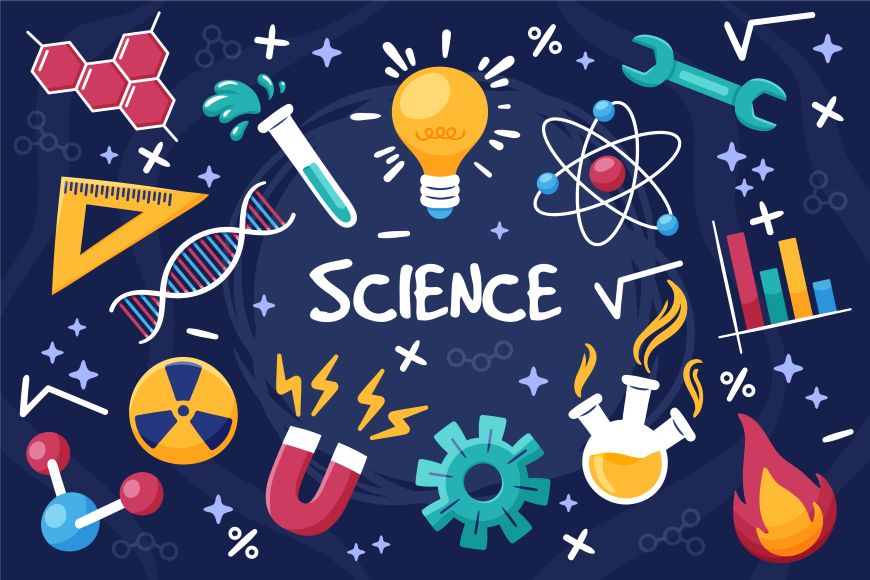
Science, Technology, Engineering, and Mathematics (STEM), which stands for Science, Technology, Engineering, and Mathematics, encompasses subjects that enable individuals to understand and engage with the world around them. These fields drive solutions to complex challenges and foster the creation of innovative tools and ideas. Science, Technology, Engineering, and Mathematics cultivate logical thinking, empowering people to tackle pressing issues such as climate change and healthcare advancements.
Components of STEM
Science: Learning about nature

Science helps us learn how nature works. It involves watching, testing, and guessing to explain things. Scientists use math to check their results and make sure they are correct. Ultimately, this leads to discoveries like vaccines and clean energy, both of which improve our lives.
The idea that “all swans are white” shows how science changes. Seeing one black swan proves this idea wrong. This teaches us to accept new facts.
Technology: Creating helpful tools

Technology turns ideas into tools that help us daily. It creates things like apps for rides or online classes. Machines can do boring tasks, so we can solve problems creatively. Technology also connects people everywhere, helping them work together. These tools solve big problems like better healthcare and clean energy.
Technology is a useful servant but a dangerous master. – Christian Lous Lange
Engineering: Making useful designs

Engineering mixes creativity with skills to solve problems. Engineers use special methods to make better and greener products. For example, improving solar panels saves energy and cuts pollution. By conserving resources and minimizing waste, engineering actively contributes to protecting our planet.
Nothing in life is to be feared, it is only to be understood.
Mathematics: The key to problem-solving

Math is the base of STEM – Science Technology Engineering Mathematics. It helps solve problems using logic and numbers. For example, businesses use math to set prices and profits. Engineers use math to plan buildings and machines. Math is a global tool for smart choices in many areas like money and tech.
Without mathematics, there’s nothing you can do
Why STEM?
Boosting new ideas and technology
STEM enhances technology and science to drive progress. Additionally, it provides tools for solving challenges and improving lives. Recently, education has evolved significantly to meet modern needs.
From 2014 to 2019, learning focused on proven methods.
Between 2019 and 2021, teachers and schools improved.
From 2021 to 2023, fairness and coding became key topics.
These changes clearly show how STEM keeps up with a fast-moving world. Also, it sparks creativity and problem-solving. Also, it drives innovations like smart computers and green energy.
STEM in Everyday Life
Think about your day. The alarm clock that wakes you up? That’s technology. The bridge you cross on the way to school? That’s engineering. The medicine that helps you when you’re sick? That’s science. Even math helps! It’s used in shopping, sports, and even making music i.e., STEM is everywhere!
Science Advantages
STEM helps solve major challenges—such as climate change, space exploration, and new medicines. Moreover, kids learning Science, Technology, Engineering, and Mathematics can invent and create to make an impact. For example, you could design faster cars, build stronger homes, or fight pollution. Ultimately, the future relies on problem-solvers like you!
Technology Advantages
Technology helps make STEM learning fun and exciting! It lets kids explore science with cool tools like robots, apps, and virtual labs. Computers help solve math problems faster, and machines make big jobs easier. With technology, students can build, create, and discover new things, just like real scientists and engineers!
Making STEM Fun
Some kids think STEM is just hard math and tough science. However, that’s not true! It is about asking questions, exploring ideas, and solving problems. You can start small—try building something, coding a simple game, or learning cool science experiments at home.
Schools and events like STEM fairs and youth conferences also help students discover new activities. These events make learning fun by showing real-world experiments, hands-on projects, and cool tech demonstrations.
Solving big problems
STEM helps fix global problems. For example, 70% of young people worry about climate change. Science and Technology give tools to create clean energy and eco-friendly ways to live. Health leads to better treatments, and you can help solve these problems and make the world better.
The STEM Adventure
The website is associated with the National Youth Conference on STEM 2025. This conference provides a platform for students in grades 8 to 12 to highlight their research papers, posters, and projects related to Science, Technology, Engineering, and Mathematics (STEM). It aims to enhance students’ profiles and foster innovation.
STEM’s Role in Preparing for a Technology-Driven Future.
The world is increasingly focused on technology. Learning, therefore prepares you for this shift. Moreover, problem-solving skills are key to exploring a tech-filled future. Additionally, it opens career paths and drives global innovation.
Why is STEM Education Crucial for Future Job Opportunities? STEM skills help students succeed in jobs and grow the economy. Teaches tech skills through hands-on projects and real-world tasks.
FAQ’s
What does STEM stand for?
STEM means Science, Technology, Engineering, and Mathematics. Therefore, areas focus on solving problems and creating new ideas. It gives you skills to do well in school, work, and life in detail.
Why is Science and Technology important for students?
STEM improves critical thinking and also strengthens problem-solving. In addition, it builds teamwork skills for jobs and daily life. Moreover, it sparks creativity and curiosity, helping you adapt to a fast-changing world.
Can anyone learn STEM skills?
Yes, everyone can learn STEM skills! Moreover, programs include all learners.
How does STEM prepare you for the future?
STEM- Science, Technology, Engineering, and Mathematics teaches coding and also builds teamwork skills. It further inspires creative thinking to tackle challenges and opportunities.
What careers can STEM lead to?
STEM opens doors to careers in tech, healthcare, and engineering. For example, you could become a software developer, scientist, or engineer. Moreover, these jobs let you tackle real-world problems and finally create positive change.